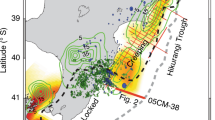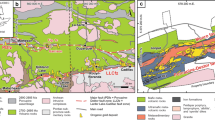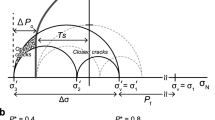Abstract
Some faults seem to slip at unusually high angles (>45°) relative to the orientation of the greatest principal compressive stress1,2,3,4,5. This implies that these faults are extremely weak compared with the surrounding rock6. Laboratory friction experiments and theoretical models suggest that the weakness may result from slip on a pre-existing frictionally weak surface7,8,9, weakening from chemical reactions10, elevated fluid pressure11,12,13 or dissolution–precipitation creep14,15. Here we describe shear veins within the Chrystalls Beach accretionary mélange, New Zealand. The mélange is a highly sheared assemblage of relatively competent rock within a cleaved, anisotropic mudstone matrix. The orientation of the shear veins—compared with the direction of hydrothermal extension veins that formed contemporaneously—indicates that they were active at an angle of 80°±5° to the greatest principal compressive stress. We show that the shear veins developed incrementally along the cleavage planes of the matrix. Thus, we suggest that episodic slip was facilitated by the anisotropic internal fabric, in a fluid-overpressured, heterogeneous shear zone. A similar mechanism may accommodate shear at high angles to the greatest principal compressive stress in a range of tectonic settings. We therefore conclude that incremental slip along a pre-existing planar fabric, coupled to high fluid pressure and dissolution–precipitation creep, may explain active slip on severely misoriented faults.
This is a preview of subscription content, access via your institution
Access options
Subscribe to this journal
Receive 12 print issues and online access
$259.00 per year
only $21.58 per issue
Buy this article
- Purchase on Springer Link
- Instant access to full article PDF
Prices may be subject to local taxes which are calculated during checkout




Similar content being viewed by others
References
Zoback, M. D. et al. New evidence on the state of stress of the San Andreas fault system. Science 238, 1105–1111 (1987).
Hreinsdóttir, S. & Bennett, R. A. Active aseismic creep on the Alto Tiberina low-angle normal fault, Italy. Geology 37, 683–686 (2009).
Wernicke, B. Low-angle normal faults and seismicity: A review. J. Geophys. Res. 100, 20159–20174 (1995).
Casciello, E., Cesarano, M. & Pappone, G. Extensional detachment faulting on the Tyrrhenian margin of the southern Apennines contractional belt (Italy). J. Geol. Soc. Lond. 163, 617–629 (2006).
Chiaraluce, L., Chiarabba, C., Collettini, C., Piccinini, D. & Cocco, M. Architecture and mechanics of an active low-angle normal fault: Alto Tiberina Fault, northern Apennines, Italy. J. Geophys. Res. 112, B10310 (2007).
Jaeger, J. C. & Cook, N. G. W. Fundamentals of Rock Mechanics 3rd edn (Chapman & Hall, 1979).
Moore, D. E. & Rymer, M. J. Talc-bearing serpentinite and the creeping section of the San Andreas fault. Nature 448, 795–797 (2007).
Collettini, C., Niemeijer, A., Viti, C. & Marone, C. Fault zone fabrics and fault weakness. Nature 462, 907–910 (2009).
Lachenbruch, A. H. Frictional heating, fluid pressure, and the resistance to fault motion. J. Geophys. Res. 85, 6249–6272 (1980).
Wintsch, R. P., Christoffersen, R. & Kronenburg, A. K. Fluid-rock reaction weakening of fault zones. J. Geophys. Res. 100, 13021–13032 (1995).
Hubbert, M. K. & Rubey, W. W. Role of fluid pressure in mechanics of overthust faulting. Geol. Soc. Am. Bull. 70, 115–206 (1959).
Rice, J. R. in Fault Mechanics and Transport Properties of Rocks (eds Evans, B. & Wong, T. F.) 475–503 (Academic, 1992).
Faulkner, D. R., Mitchell, T. M., Healy, D. & Heap, M. J. Slip on ‘weak’ faults by the rotation of regional stress in the fracture damage zone. Nature 444, 922–925 (2006).
Bos, B. & Spiers, C. J. Experimental investigation into the microstructural and mechanical evolution of phyllosilicate-bearing fault rock under conditions favouring pressure solution. J. Struct. Geol. 23, 1187–1202 (2001).
Niemeijer, A. R. & Spiers, C. J. Velocity dependence of strength and healing behaviour in phyllosilicate-bearing fault gouge. Tectonophysics 427, 231–253 (2006).
Ramsay, J. M. & Chester, F. M. Hybrid fracture and the transition from extension fracture to shear fracture. Nature 428, 63–66 (2004).
Collettini, C. & Sibson, R. H. Normal faults, normal friction? Geology 29, 927–930 (2001).
Byerlee, J. D. Friction of rocks. Pure Appl. Geophys. 116, 615–626 (1978).
Nelson, K. D. A suggestion for the origin of mesoscopic fabric in accretionary mélange, based on features observed in the Chrystalls Beach Complex, South Island, New Zealand. Geol. Soc. Am. Bull. 93, 625–634 (1982).
Nishimura, Y., Coombs, D. S., Landis, C. A. & Itaya, T. Continuous metamorphic gradient documented by graphitization and K–Ar age, southeast Otago, New Zealand. Am. Mineral. 85, 1625–1636 (2000).
Durney, D. W. & Ramsay, J. G. in Gravity and Tectonics (eds De Jong, K. & Scholten, R.) 67–96 (Wiley, 1973).
Cosgrove, J. W. The interplay between fluids, folds and thrusts during the deformation of a sedimentary succession. J. Struct. Geol. 15, 491–500 (1993).
Lister, G. S. & Williams, P. F. The partitioning of deformation in flowing rock masses. Tectonophysics 92, 1–33 (1983).
Sibson, R. H. Structural permeability of fluid-driven fault-fracture meshes. J. Struct. Geol. 18, 1031–1043 (1996).
Lehner, F. K. & Bataille, J. Non-equilibrium thermodynamics of pressure solution. Pure Appl. Geophys. 122, 53–85 (1985).
Sibson, R. H. Rupturing in overpressured crust during compressional inversion—the case from NE Honshu, Japan. Tectonophysics 473, 404–416 (2009).
Lockner, D. A. Rock Physics and Phase Relations, A Handbook of Physical Constants 127–147 (AGU, 1995).
Morrow, C. A., Radney, B. & Byerlee, J. D. in Fault Mechanics and Transport Properties of Rocks (eds Evans, B. & Wong, T. F.) 69–88 (Academic, 1992).
Secor, D. T. Role of fluid pressure in jointing. Am. J. Sci. 263, 633–646 (1965).
Acknowledgements
We thank R. J. Norris for discussion. A.F. gratefully acknowledges financial support from a GNS Science Hazards Scholarship and an Otago University Postgraduate Publishing Grant. A. R. Niemeijer and D. Faulkner provided critical reviews, which significantly improved the paper.
Author information
Authors and Affiliations
Contributions
A.F. and F.R. carried out the field and microstructural studies. R.H.S. designed the study. All authors contributed to the writing.
Corresponding author
Ethics declarations
Competing interests
The authors declare no competing financial interests.
Rights and permissions
About this article
Cite this article
Fagereng, Å., Remitti, F. & Sibson, R. Shear veins observed within anisotropic fabric at high angles to the maximum compressive stress. Nature Geosci 3, 482–485 (2010). https://doi.org/10.1038/ngeo898
Received:
Accepted:
Published:
Issue Date:
DOI: https://doi.org/10.1038/ngeo898
This article is cited by
-
A likely geological record of deep tremor and slow slip events from a subducted continental broken formation
Scientific Reports (2022)
-
Geological constraints on the mechanisms of slow earthquakes
Nature Reviews Earth & Environment (2021)
-
An investigation into the role of time-dependent cohesion in interseismic fault restrengthening
Scientific Reports (2019)
-
Fluid overpressure from chemical reactions in serpentinite within the source region of deep episodic tremor
Nature Geoscience (2019)
-
Tensile overpressure compartments on low-angle thrust faults
Earth, Planets and Space (2017)



